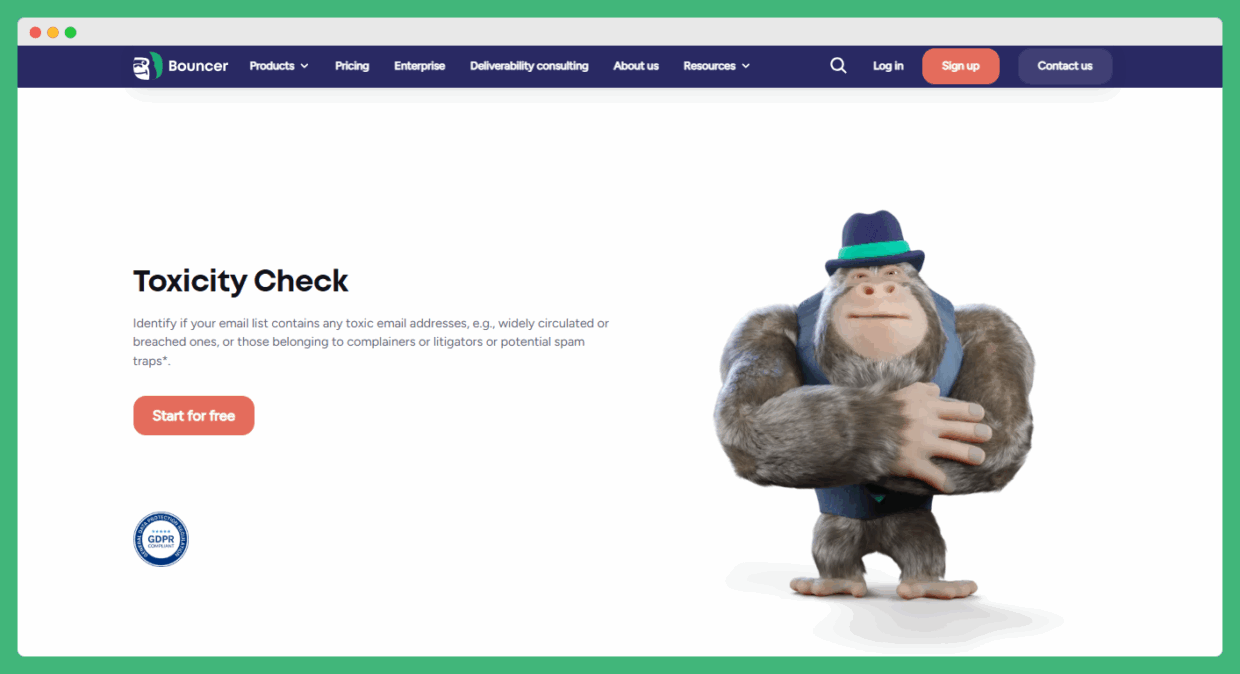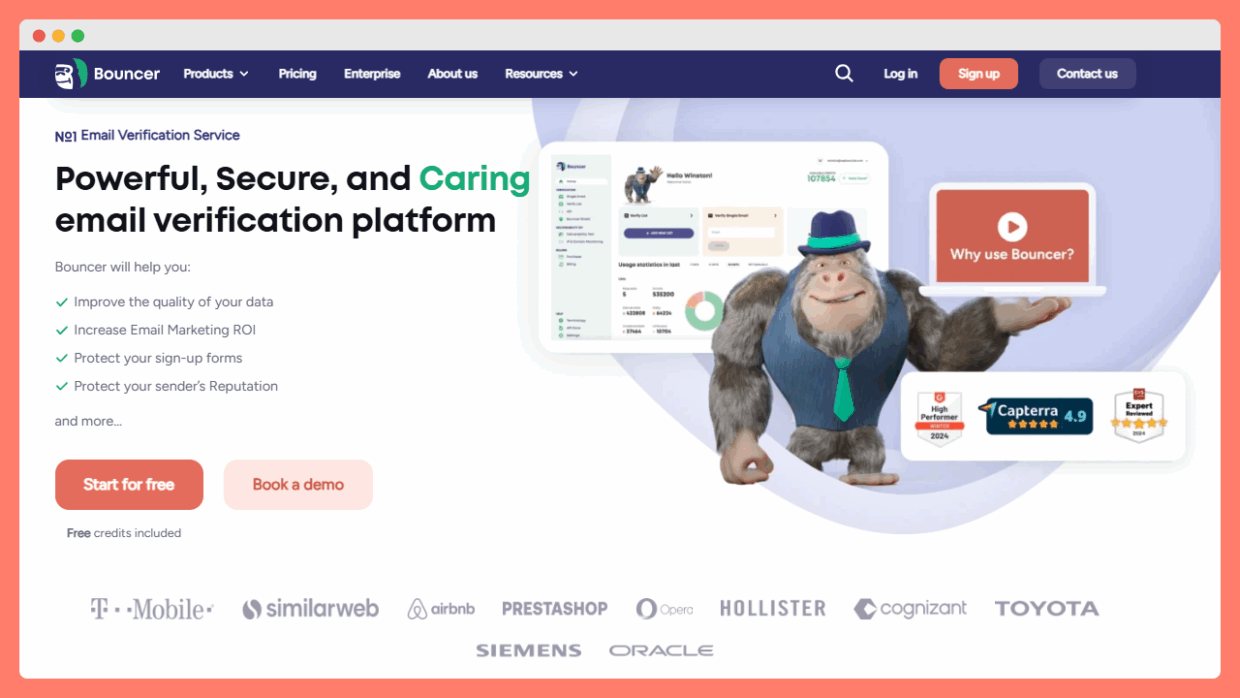That’s the cold truth about email marketing. And you can’t just ignore bounces. After all, they tell you your emails aren’t landing in the recipient’s inbox, so it would be good to find out why and eliminate any reason behind it. So, how to reduce email bounce rate and keep your campaigns alive?
The answer isn’t complicated, but it does require some smart habits and a clean approach to managing your list. Let’s break it down.
What is an email bounce rate (and why it matters)?
An email bounce rate shows you the percentage of emails that never made it to their destination. Out of 100 messages you send, if 5 never get delivered, your bounce rate is 5%.
What’s an acceptable bounce rate? Most experts will tell you that under 2% is fine, though it depends a bit on your industry. Anything higher than that is a yellow/red flag that your list or process needs work.
The average bounce rate across all industries usually falls between 0.7%. Thus, if you’re sitting above that range, you’re risking more than a couple of missed emails. You’re putting your domain and future campaigns at risk.
That’s because high bounce rates drag down email deliverability. Inbox providers like Gmail or Outlook judge you based on how many of your emails cause problems. Too many bounced emails, and they’ll start pushing your campaigns into spam instead of the inbox.
Moreover, your sender reputation follows you. Once it drops, it’s tough to bring it back up.
That’s why small and medium brands should lean on a reputable email service provider. A good email service provider won’t just send messages for you. It’ll help protect your reputation with tools like list validation and deliverability monitoring.
Hard bounces vs soft bounces
Not all bounces are the same.
Hard bounces are permanent. They happen when there’s a permanent delivery failure – like when the email address simply doesn’t exist. Maybe the person mistyped when signing up. Maybe they left the company, and their inbox was shut down. Either way, these hard-bounced email addresses will never work.
Soft bounces are temporary. They occur when something blocks delivery for a moment. Maybe the recipient’s email server is down. Maybe the recipient’s mailbox is full. Or maybe the message is too large. These are still email bounces, but they might clear on the next attempt.
For your campaigns, you can’t afford to keep hard bounces in your list. They drag your numbers down for no reason. Soft bounces you can tolerate for a while, but if the same contact soft bounces again and again, treat it as dead weight.

The hidden costs of a high email bounce rate
Unfortunately, a high bounce rate does more than block a few emails. It eats into your business in sneaky ways.
First, you’re wasting ad spend and time. If you drive traffic to your site, collect addresses, and then a chunk of those turn into bounced emails, that’s lost money. You paid for leads that don’t exist.
Second, every bounce hurts your sender’s reputation. Inbox providers notice patterns. If your campaigns send too many failed messages, they assume you’re careless or even spamming. That’s when your email campaign starts landing in junk folders—even for valid contacts.
Third, there’s the snowball effect. High bounce rates increase the chance of spam filters catching your messages. More filters mean fewer delivered emails. Add in spam complaints from frustrated contacts, and you’ve got a recipe for collapse.
For small and medium businesses, the negative impact can last for a long period. A single high email bounce rate can mess up your outreach for months. The problem isn’t just about the number of bounced emails. It’s about how those errors shape your reputation across the whole email ecosystem.
The quick rescue plan: How to reduce your email bounce rate today
Alright, enough doom and gloom. Let’s get to the good part: action.
If you’re staring at a messy subscriber list or worrying about bounces, here’s your first-aid kit.
Verify email addresses before sending
Never trust a raw list. People type too fast, forms collect fake sign-ups, and old leads decay over time. That’s why the very first step is to verify email addresses before you hit send. Fortunately, many tools can do that for you.
Verification tools connect with the recipient’s email server to check if an inbox is real and ready. They flag risky contacts so you don’t waste time on dead leads. Cleaning your list this way cuts down the number of bounced emails and gives you more delivered emails instantly. For small businesses, it’s the fastest way to bring bounce rates low without touching your content.
Use double opt-in to confirm new subscribers
New sign-ups are exciting, but not all of them are real. A double opt-in acts like a filter. Someone enters their address, and they only join your list once they confirm by clicking the link in a follow-up message.
This simple step blocks typos, bots, and fake accounts from sneaking into your email marketing campaigns. It also means your list fills up with active subscribers, people who actually want your content. In the long run, a double opt keeps your bounce rate lower and helps maintain a good sender reputation.
Clean list from already existing bad addresses
When an address triggers a hard bounce, it’s done. That’s a permanent delivery failure. It happens when the contact left their job, deleted their account, or never existed in the first place. Hanging on to these addresses hurts your sender reputation and makes you look reckless to inbox providers.
The fix? Remove hard-bounced email addresses as soon as you spot them – tools such as Bouncer AutoClean can handle it automatically.
Connected to your CRM, Bouncer checks new contacts every hour, removes undeliverables, and keeps your list fresh in the background. That way, you don’t have to worry about outdated data slipping in and hurting your results.
Check toxicity
Some addresses look valid but are actually dangerous. They can belong to people who often file spam complaints, addresses that got leaked in breaches, or even hidden spam traps.
Thus, run a toxicity check, with tools like Bouncer. It scores each contact on a scale, so you know which ones might cause trouble. It looks at widely circulated addresses, breached or hacked inboxes, and patterns used by blacklists. The higher the score, the greater the chance that the address could harm your email deliverability.

Ditch free sender domains
Want to look like a real brand? Then skip free sender domains like Gmail, Yahoo, or Outlook for bulk campaigns. They may be fine for personal use, but for business, they cause problems. Many email servers treat them as suspicious when used for mass sending, which means more spam complaints and fewer delivered emails.
The solution is simple: send from your own domain. Add proper DNS records like SPF, DKIM, and DMARC to protect your identity and prove you’re legitimate. This one step can transform your email deliverability and help you build a good reputation with providers.
Warm up inboxes before scaling
Launching a new account? Don’t go big on day one. A fresh inbox sending hundreds of marketing emails out of nowhere looks fishy. Inbox providers monitor volume, and a sudden spike can trigger blocks.
Instead, warm up your new mailboxes. Start small, send a handful of email messages each day, then slowly increase volume. This creates a track record of safe sending and reassures providers that you’re not spamming. Over a few weeks, you’ll be ready to scale without risking a high email bounce rate.
Smart habits that keep bounce rates low
Quick fixes work, but what really protects your email marketing is building habits. They can keep your list healthy and your reputation strong.
Where should you start?
#1 Review list quality often
A clever subject line might help you grab attention, but if your list is full of broken or outdated contacts, it won’t matter. A clean list always beats flashy words. Thus, review your email list often. Cut inactive or invalid addresses.
The fewer bounces, the better your future results.
#2 Always segment prospects & send fewer but better marketing emails
Blasting one email to everyone doesn’t work anymore. Instead, split your subscribers into groups. New buyers get one type of content, loyal fans get another. By segmenting, your marketing emails feel more relevant, which leads to better engagement rates.
And when your audience interacts with your content, inbox providers reward you with stronger email deliverability.
#3 Track delivered emails and engagement for every campaign
Every email campaign should be measured. Don’t stop at open rates. Check how many delivered emails you actually achieved. Then look at clicks, replies, and conversions. This tells you if your habits are paying off.
If you see a spike in bounces or drops in engagement, act before it snowballs.
The long game: building a good sender reputation
A good sender reputation opens inbox doors. A bad one slams them shut. And just like credit, it takes time to build and seconds to ruin. However, we have some best practices that will help you maintain a good reputation for a long time.
Stay consistent with email marketing campaigns
Inbox providers don’t like surprises. If you send nothing for months and then dump thousands of messages in one day, alarms go off. Keep a steady rhythm. Even small email marketing campaigns sent regularly show you’re trustworthy. It also helps you spot issues faster before they cause a high bounce rate.
Run re-engagement campaigns for inactive subscribers
Old contacts who never click or reply hurt your stats. They make your list look weak, and in some cases, they might even trigger spam filters. Instead of ignoring them, launch a re-engagement campaign. Send a friendly “still interested?” message. If they ignore you after that, let them go. It keeps your bounce rates low and your database clean.
Avoid spam complaints by sending only to active subscribers
Nothing kills trust faster than spam complaints. Even a few can cause major damage to your sender reputation. The safest route? Only send emails to active subscribers who’ve recently confirmed interest. That way, your audience welcomes your content instead of flagging it.
Test across different email clients
Your emails don’t look the same in every tool. What renders fine in Gmail may break in Outlook. Broken formatting sometimes increases bounced emails or leads to ignored messages. Test your content in multiple email clients before launch. A polished email message has a better chance of staying in the recipient’s inbox.
Measure delivered emails, not just sent
Many brands brag about how many messages they “sent.” That’s vanity. The only number that matters is how many were delivered. Tracking delivered emails helps you spot early signs of problems like technical issues or growing bounces.
Bounced emails? Get rid of them with Bouncer
Well, no matter how careful you are, you’ll always face bounces. Addresses change, domains expire, and servers shut down. You can’t control everything. But you can control how you handle it.
That’s where Bouncer is needed. It’s built to reduce your email bounce and keep your campaigns safe.

Here’s why small and medium brands love it:
- Real-time verification: Every address is checked before you hit send. That means fewer surprises and fewer hard bounces.
- List cleaning at scale: Got an old subscriber list? Upload it, and Bouncer removes invalid or risky contacts so your bounce rates stay low.
- Protect your sender reputation: By clearing out hard-bounced email addresses, you avoid the chain reaction of spam filters and negative impact on deliverability.
- Save money: Why pay your ESP to try sending to fake contacts? Cleaning your list cuts costs across all email marketing campaigns.
Imagine the peace of mind: you launch a campaign knowing your email addresses are valid, your domain is safe, and your good reputation is intact. That’s the power of working with a tool like Bouncer.
Wrap-up
Keeping bounce rates low isn’t rocket science. It’s a mix of smart habits and the right tools. Focus on list quality instead of flashy subject lines. Segment and personalize your marketing emails. Measure delivered emails every time. Build a good sender reputation through consistency, re-engagement, and avoiding spam complaints.
And when you do face bounced emails, don’t let them drag you down. Clean them out with Bouncer and keep your campaigns fresh.
At the end of the day, reducing bounces means more emails reaching the right people, more conversations, more sales, and more confidence every time you send.


